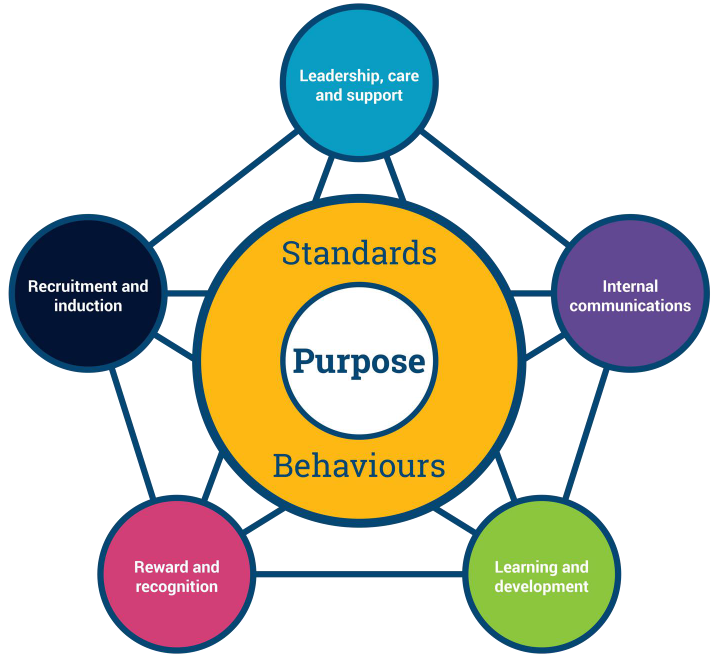/CES/Designing%20a%20customer-centric%20culture.jpg?width=615&name=Designing%20a%20customer-centric%20culture.jpg)
Culture is all around us, influencing our ideas, customs and social behaviour, and culture exists within an organisation whether we are conscious of it or not. Despite its importance, managers rarely address the elements of organisational culture, or reflect on how culture can be designed to enable a system that creates superior value for their customers.
The role of culture in customer centricity
Companies understand that they must create value for customers, but technology is multiplying the interactions that define the customer’s experience, requiring organisations to become increasingly complex. At the same time, market maturity and globalisation are driving up standards, so customers demand not just the basics of a product to be right but also that every interaction with the organisation should be great.
A customer strategy is needed. Simplifying the complexity into a clear definition of our target segments and the value we will create for each one. We need experience design competence, not just product and service design skills, to map out how this value will be created over time in customer journeys. We need systems and processes that seamlessly support these journeys. We need metrics to check how we are progressing in the customers’ eyes, and all this needs to be tied together by a single-minded focus on creating the value sought by customers.
But experience design has its limits. Micro-managing every detail of how our people should behave is demoralising, inefficient and impossible. A culture is therefore needed that gives everyone the clarity to stay on the same course, but that empowers people to take spontaneous, creative and flexible decisions.
Designing a culture that empowers
All organisations have a culture. Culture forms with or without clear intent. Simply put, culture can be defined as “the way we do things around here”. Organisations that do not consciously address their culture risk an ethos emerging that is internally focused and counterproductive to a proclaimed ambition to create great customer experiences. But as culture is so intricately embedded into an organisation – expressed in its implicit values, behavioural habits, language, symbols and so on - it can seem very intangible and overwhelmingly hard to change.
But although the commitment required to change culture should not be underestimated, conscious design of culture is possible. Culture embeds a group’s explicit or implicit goals, so in a customer-led organisation it must be designed to keep people focused instinctively on customers.
This may seem paradoxical: designing a system that encourages spontaneity. But the alternative of dehumanising tight scripting doesn’t work; neither does a free-for-all. We are struck by how often we see employees who are neither empowered nor equipped to make good, consistent and customer-led decisions, leading not only to unhappy customers, but also to unhappy employees. So, we must grapple with the paradox of steering employees towards spontaneity
Drawing from leaders in customer centricity, this framework outlines what needs to be done.

- The organisation must define its purpose: a statement that summarises precisely what it does for its customers.
- It must connect all employees to the purpose, and create the operational precision that many organisations lack, by defining standards and associated
- These guidelines are constantly reinforced through all four aspects of HR practice: recruitment and induction, learning and development, internal communications, and reward and recognition.
- Finally, leadership behaviours are crucial in reinforcing these principles rather than contradicting them.
Our work in this area is critical to transforming leaders and organisations into customer centricity. Frequent headache in these transformations is culture and how it influences people. Processes and systems can be changed, but if leaders don’t bring people along the journey then change won’t be transformational.
Through our Customer Experience Strategy programme and on-going dialogue with members of the Cranfield Customer Management Forum, as well as through our research with companies undergoing transformations, we’ve developed a range of tools to help organisations and leaders make this transition.
Visit Cranfield Customer Management Forum, to find out more information about our work, developed tools and how we are refining the current understanding of elements of organisational culture and how this supports organisational customer centricity.
Blog produced by: Cranfield School of Management, Cranfield Customer Management Forum and Customer Experience Strategy Programme.
Read more:
-
Marketing Leadership – Steeping up to the challenges of Post Brexit Britain
-
Advance your career: How to go from middle weight to heavy weight in 2019


/CES/Designing%20a%20customer-centric%20culture.jpg)
